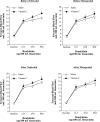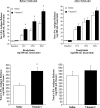Nebivolol, But Not Metoprolol, Treatment Improves Endothelial Fibrinolytic Capacity in Adults With Elevated Blood Pressure
- PMID: 29122812
- PMCID: PMC5721799
- DOI: 10.1161/JAHA.117.007437
Nebivolol, But Not Metoprolol, Treatment Improves Endothelial Fibrinolytic Capacity in Adults With Elevated Blood Pressure
Abstract
Background: Vascular endothelial fibrinolytic function is impaired in adults with prehypertension and hypertension and plays a mechanistic role in the development of atherothrombotic events. The influence of β-blockers on endothelial fibrinolysis is unknown. This study compared the effects of chronic nebivolol and metoprolol treatment on endothelial tissue-type plasminogen activator (t-PA) release in adults with elevated blood pressure (BP).
Methods and results: Forty-four middle-aged adults (36% women) with elevated BP completed a 3-month, double-blind, randomized, placebo-controlled trial comparing nebivolol (5 mg/d), metoprolol succinate (100 mg/d), and placebo. Net endothelial t-PA release was determined in vivo in response to intrabrachial infusions of bradykinin and sodium nitroprusside before and after each intervention. In a subset, the dose-response curves to bradykinin and sodium nitroprusside were repeated with a coinfusion of the antioxidant vitamin C. At baseline, resting BP and endothelial t-PA release were comparable between the 3 groups. BP decreased to a similar extent (≈10 mm Hg) in the nebivolol- and metoprolol-treated groups. There was a substantial increase (≈30%; P<0.05) in the capacity of the endothelium to release t-PA following chronic treatment with nebivolol but not metoprolol or placebo. Mitigating oxidant stress with vitamin C coinfusion potentiated t-PA release (90%; P<0.05) at baseline in all groups. However, after the intervention, t-PA release was unchanged by vitamin C coinfusion in the nebivolol group only.
Conclusions: Nebivolol but not metoprolol improves endothelial t-PA release in adults with elevated BP. This may be an important vascular benefit of nebivolol.
Clinical trial registration: URL: http://www.clinicaltrials.gov. Unique identifier: NCT01595516.
Keywords: hypertension; metoprolol; nebivolol; oxidative stress; tissue‐type plasminogen activator; vitamin C.
© 2017 The Authors. Published on behalf of the American Heart Association, Inc., by Wiley.
Figures




Similar articles
-
Chronic Nebivolol Treatment Suppresses Endothelin-1-Mediated Vasoconstrictor Tone in Adults With Elevated Blood Pressure.Hypertension. 2016 Jun;67(6):1196-204. doi: 10.1161/HYPERTENSIONAHA.115.06979. Epub 2016 Apr 25. Hypertension. 2016. PMID: 27113048 Free PMC article. Clinical Trial.
-
Acute and chronic effects of vitamin C on endothelial fibrinolytic function in overweight and obese adult humans.J Physiol. 2008 Jul 15;586(14):3525-35. doi: 10.1113/jphysiol.2008.151555. Epub 2008 May 22. J Physiol. 2008. PMID: 18499730 Free PMC article. Clinical Trial.
-
Nebivolol, but not metoprolol, lowers blood pressure in nitric oxide-sensitive human hypertension.Hypertension. 2014 Dec;64(6):1241-7. doi: 10.1161/HYPERTENSIONAHA.114.04116. Epub 2014 Sep 29. Hypertension. 2014. PMID: 25267802 Free PMC article. Clinical Trial.
-
Protective effects of nebivolol from oxidative stress to prevent hypertension-related target organ damage.J Hum Hypertens. 2017 Jun;31(6):376-381. doi: 10.1038/jhh.2017.8. Epub 2017 Mar 2. J Hum Hypertens. 2017. PMID: 28252041 Free PMC article. Review.
-
Effects of nebivolol versus other antihypertensive drugs on the endothelial dysfunction in patients with essential hypertension.Biosci Rep. 2020 May 29;40(5):BSR20200436. doi: 10.1042/BSR20200436. Biosci Rep. 2020. PMID: 32342981 Free PMC article. Review.
Cited by
-
Long-term efficacy of vasodilating β-blocker in patients with acute myocardial infarction: nationwide multicenter prospective registry.Korean J Intern Med. 2021 Mar;36(Suppl 1):S62-S71. doi: 10.3904/kjim.2020.135. Epub 2020 Jul 3. Korean J Intern Med. 2021. PMID: 32615654 Free PMC article.
-
Effect of nebivolol monotherapy or combination therapy on blood pressure levels in patients with hypertension: an updated systematic review and multilevel meta-analysis of 91 randomized controlled trials.High Blood Press Cardiovasc Prev. 2025 Jan;32(1):7-31. doi: 10.1007/s40292-024-00687-5. Epub 2024 Oct 29. High Blood Press Cardiovasc Prev. 2025. PMID: 39467996
References
-
- Lip GY, Blann AD. Endothelium and fibrinolysis in hypertension: important facets of a prothrombotic state? Hypertension. 2008;52:218–219. - PubMed
-
- Ferroni P, Basili S, Paoletti V, Davi G. Endothelial dysfunction and oxidative stress in arterial hypertension. Nutr Metab Cardiovasc Dis. 2006;16:222–233. - PubMed
-
- Taddei S, Virdis A, Ghiadoni L, Magagna A, Salvetti A. Vitamin c improves endothelium‐dependent vasodilation by restoring nitric oxide activity in essential hypertension. Circulation. 1998;97:2222–2229. - PubMed
-
- Hrafnkelsdottir T, Ottosson P, Gudnason T, Samuelsson O, Jern S. Impaired endothelial release of tissue‐type plasminogen activator in patients with chronic kidney disease and hypertension. Hypertension. 2004;44:300–304. - PubMed
MeSH terms
Substances
Associated data
Grants and funding
LinkOut - more resources
Full Text Sources
Other Literature Sources
Medical

